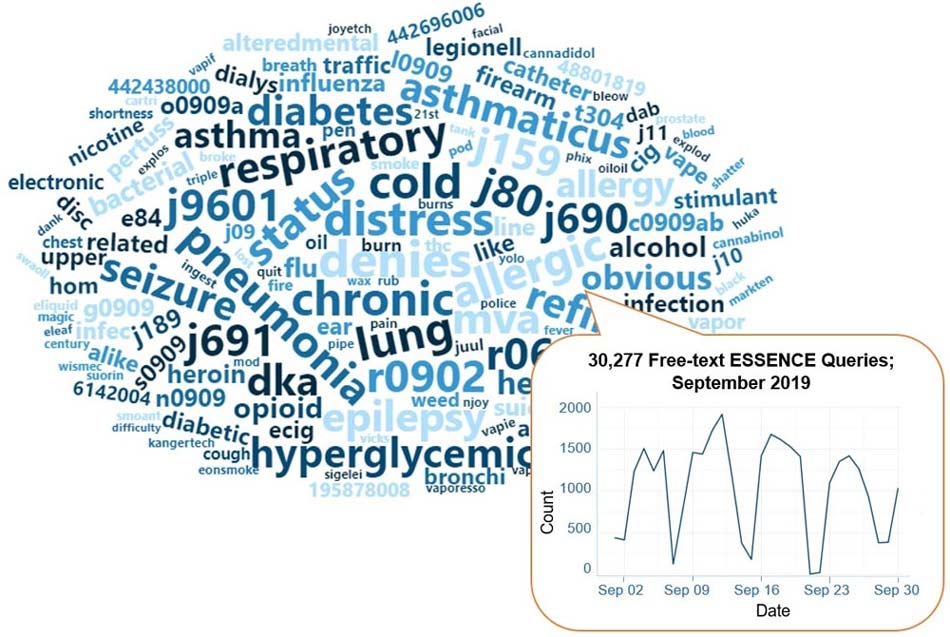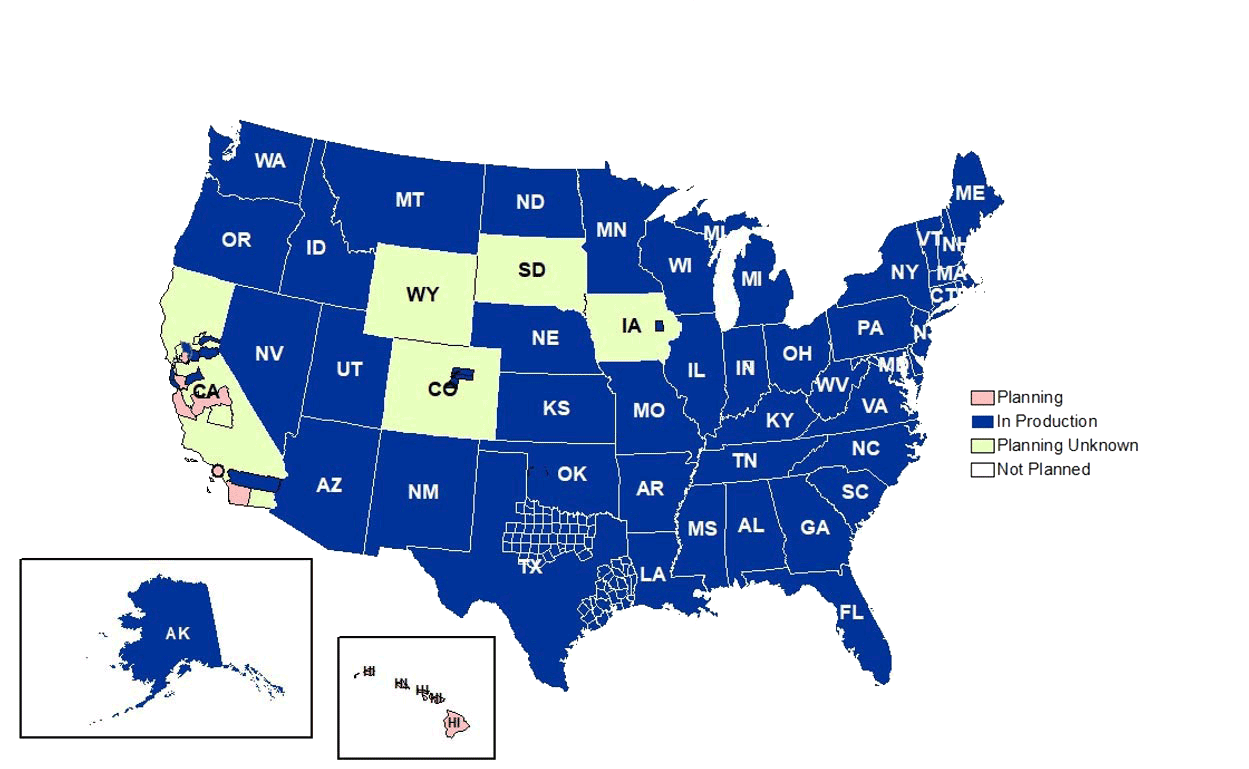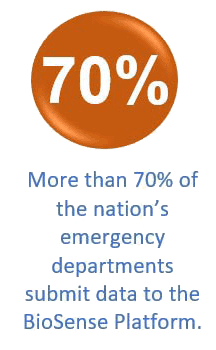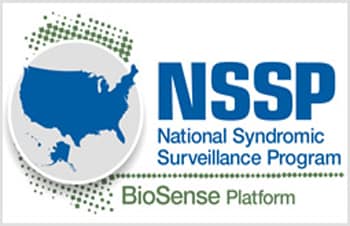NSSP Update – November 2019

- Community of Practice
- Update: CSTE is Now Facilitating the NSSP CoP
- Monthly NSSP CoP Calls
- Update Your Link to the Knowledge Repository
- Implementation Guide for Syndromic Surveillance
- Pilot Testing of Implementation Guide
- ESSENCE Queries

- Collaborations Accelerate Syndromic Surveillance Practice
- Data Quality Corner
- Are the Lights On? Here’s How NSSP Monitors Data Flow
People
Community of Practice
Update: CSTE is Now Facilitating the NSSP CoP
As a reminder, CDC selected the Council of State and Territorial Epidemiologists (CSTE) to facilitate the National Syndromic Surveillance Program Community of Practice (NSSP CoP). On November 1, 2019, CSTE began providing administrative support for NSSP CoP calendar events and calls. Members of the NSSP and CSTE teams are meeting regularly to transition other NSSP CoP activities. Both teams will provide relevant updates to the community during this process.
During the October 2019 NSSP CoP call, CSTE Program Analyst Hayleigh McCall gave an overview of the organization and expressed their interest in working with community members. She described CSTE’s past projects and current activities to support syndromic surveillance and also noted that NSSP CoP membership is free of charge and does not require CSTE membership. She indicated that the June 2020 CSTE Annual Conference will feature sessions about syndromic surveillance and that CSTE began accepting abstracts on the first of November.
See McCall’s presentation from the beginning of the October CoP call for more information about how CSTE will support collaborative opportunities. If you have questions about the transition of activities, please contact Hayleigh McCall at syndromic@cste.org or NSSP at nssp@cdc.gov.
Monthly NSSP CoP Calls
Please join your colleagues for the monthly NSSP CoP call. Calls will now be hosted on CSTE’s webinar platforms (e.g., WebEx, RingCentral), and CSTE will send relevant call information to community members. The next call will be held Tuesday, November 19, 3:00–4:30 PM ET, and the topic is NSSP CoP: A Year in Review. Join the call and get inspired as some of our influential NSSP CoP group leaders describe achievements in syndromic surveillance that are advancing science and practice.
Last month’s call titled Lung Injury Response: Come Quick, Syndromic Surveillance is Stepping in to Help Save the Day garnered considerable interest. Speakers included Natasha Close of the Washington Department of Health, Jennifer Lenahan with Public Health—Seattle & King County, Megan Patel of the Illinois Department of Public Health, and NSSP Program Manager Mike Coletta and Health Scientist Aaron Kite Powell of CDC.
The presenters described how their respective agencies were responding to the severe lung injuries response effort. Individual states presented timelines of case reports, vaping response activities, and surveillance strategy; the syndromic surveillance tools they used (lung injury queries, combined vaping and lung injury query, query validation); investigation process after identification of first case and reporting; successes and lessons learned; and current activities. They discussed how syndromic data were integrated into the greater surveillance picture and public health actions that were taken based largely on timely syndromic data.
Check out this and other CoP monthly call videos in the NSSP CoP Knowledge Repository.
Update Your Link to the Knowledge Repository
A change is in the works. On November 12, 2019, the URL for the NSSP CoP Knowledge Repository (KR) will move to a new domain at knowledgerepository.syndromicsurveillance.org. Although you should be redirected to the new website, please bookmark the new URL.
Implementation Guide for Syndromic Surveillance
Final edits to the Implementation Guide for Syndromic Surveillance Release 1.0 were completed in June 2019, thanks to Community of Practice participation. In July 2019, the guide was posted on the HL7 website, and the National Institute of Standards and Technology Implementation Authoring Tool (NIST IGAMT) released the message validation tool for testing. NIST IGAMT is an open access tool, so anyone can enter the site as a guest user to validate messages for this specification.
On October 26, 2019, the Implementation Guide was posted for public use. You can download the document by visiting http://www.hl7.org/implement/standards/product_brief.cfm?product_id=503.
| HL7 2.5.1 Implementation Guide Milestones* | |
|---|---|
| Time Frame | Activity |
| 2015 | Completed Version 2.0 Final RELEASE** |
| 2016 | Released Erratum and Clarification Documents for Version 2.0 |
| 2017 Summer | Released Version 2.2 Working Draft for Community Comment and Consensus |
| 2017 Winter | Released Version 2.3 for Review and Community Comment |
| 2018 March | Released Version .09 |
| October 26, 2019 | Released to Public: HL7 2.5.1 Implementation Guide for Syndromic Surveillance Version 1 as a Standard for Trial Use for the General Public |
| Fall 2019 | Plan for Pilot Testing of Implementation Guide |
| 2020 | PROPOSED—Conduct Pilot Test of Implementation Guide |
| 2019 September–2022 September | Publish Standard for Trial Use for Period of 1 to 3 years (during which time additional comments may be submitted and dispositioned and additional releases of the guide published) |
* Milestones revised October 29, 2019. Milestones may change depending on agency and program priorities.
** Version 2.0 is currently being used; subsequent versions are working drafts only.
Shaded activities have been completed.
Pilot Testing of Implementation Guide

Let’s kick the tires and take the Implementation Guide for a spin. In the next few months, NSSP will lead pilot tests for electronic health record (EHR) vendors, hospitals, and health departments. The pilot will assess whether business processes across these organizations can support the new guidance with reasonable effort.
This standard will guide the community’s efforts for years to come. If you would like to volunteer, we’re beginning the planning process and scoping out the evaluative measures for the pilots. We anticipate that the pilots will begin in 2020. We could use your help making sure messages are complete, processed seamlessly, and received intact. More details will be shared soon. If interested, please email nssp@cdc.gov.
ESSENCE QUERIES

Query Terms from September 2019
A key feature of NSSP–ESSENCE is its ability to use free-text definitions across different fields to generate custom queries. The syndromic surveillance community can use this feature to develop and refine category definitions and to identify and respond to public health events that may not be apparent in established categorical definitions (i.e., syndromes, subsyndromes, and Chief Complaint and Discharge Diagnosis [CCDD] categories).
This word cloud summarizes free-text and coded values that epidemiologists and data analysts queried in ESSENCE during September 2019. We created it by using the Wordcloud2 package in RStudio. The relative size of the terms suggests the frequency of use in a query. NSSP super administrators can query ESSENCE usage logs to learn what queries are run nationwide and how long they take to complete.
Practice
Collaborations Accelerate SyS Practice

Collaborations initiated by the NSSP CoP Steering Committee (and its workgroups and committees) and health departments partnering with CDC programs are improving how syndromic surveillance gets done. The list of collaborations that follows, while not exhaustive, summarizes ongoing efforts to develop and improve syndrome definitions, conduct pilot tests and exercises, and improve processes to achieve public health goals more efficiently.
Here are the collaborations rapidly moving us into 2020:
Three-month Outlook:
- Develop a sexual violence v3 definition.
- Collaborator: CDC’s Division of Violence Prevention
- JUST RELEASED! Check out the syndrome in ESSENCE.
- Develop syndrome definition for the bacterial tickborne Lyme disease, querying for direct mentions of Lyme disease, bull’s-eye rash, and Lyme disease ICD-10 and SNOMED codes.
- Collaborator: CDC’s Division of Vector-Borne Diseases
- JUST RELEASED! Check out the syndrome in ESSENCE.
- Develop syndrome definition for tick exposures, searching chief complaints for various forms of the term “Tick” when relevant to an arthropod-related exposure as a possible proxy for tickborne disease surveillance and detection of seasonal peaks.
- Collaborator: CDC’s Division of Vector-Borne Diseases
- JUST RELEASED! Check out the syndrome in ESSENCE.
- Develop syndrome definition for pregnancy, delivery, and miscarriage.
- Collaborator: CDC’s Maternal and Infant Health/Maternal and Infant Health Branch (MIHB)
- Scheduled for fall 2019
- Develop syndrome definition for alcohol-involved emergency department visits.
- Collaborator: Opioid and Overdose Team
- Scheduled for fall 2019
- Develop syndrome definition for injecting drug users (IDUs) and endocarditis (infection of inner lining of heart chamber and valves).
- Collaborator: CDC’s National Center for Emerging and Zoonotic Infectious Diseases, Epidemiology Research and Innovations Branch
- Scheduled for fall 2019
- Develop syndrome definition for e-scooter-related injuries. NSSP is part of the Transportation Safety Team’s e-scooter working group.
- Collaborator: CDC’s Division of Unintentional Injury Prevention and the Transportation Safety Team
- Scheduled for fall 2019
- Develop syndrome definition for motor vehicle collision syndrome.
- Collaborator: CDC’s Division of Unintentional Injury Prevention and the Transportation Safety Team
- Scheduled for fall 2019
- Develop syndrome definition for child abuse and neglect.
- Collaborator: CDC’s Division of Violence Prevention
- Develop syndrome definition for child sexual abuse.
- Collaborator: CDC’s Division of Violence Prevention
- Develop syndrome definition for sex trafficking.
- Collaborator: CDC’s Division of Violence Prevention
- Develop syndrome definition for teen dating violence.
- Collaborator: CDC’s Division of Violence Prevention
- Develop syndrome definition for homeless populations.
- Collaborator: CDC’s Division of Violence Prevention
- Develop syndrome definition for animal bites.
- Develop syndrome definition for marijuana v3.
- Collaborator: CDC’s Opioid and Overdose Team
- Develop syndrome definition for synthetic marijuana.
- Collaborator: CDC’s Opioid and Overdose Team
- Update syndrome definition for Influenza-like Illness (ILI) CCDD category.
- Collaborator: CDC’s Influenza Division
2019–2020:
- NSSP is evaluating the detection methods for CC, DD, and CCDD fields to identify whether field choice affects how signals or alerts are created. NSSP will test multiple algorithms to filter for the most meaningful alerts in accord with detection methods. Afterwards, NSSP will develop best practices for using detection methods.
- NSSP is working with CDC’s National Center for Environmental Health to capture radiation exposures following a radiation disaster. They are examining how syndromic data can be used to supplement existing radiation exposure surveillance using poison control center data.
- NSSP is participating in a functional exercise to gauge how well the community shares information and data during a public health event. This exercise will evaluate response speed; technical needs and delivery options; potential local, state, and federal collaborations; and integration of emergency preparedness and management personnel.
- Collaborator: NSSP CoP Syndromic Surveillance and Public Health Emergency Preparedness Response and Recovery (SPHERR) Committee
- NSSP is working with CDC’s National Center for Chronic Disease Prevention and Health Promotion, Division of Cancer Prevention and Control, on a special-interest project though the Prevention Research Centers Program: “Improving Cancer Survivor Treatment and Outcomes by Ensuring Appropriate Emergency/Acute Care Treatment.” Work will begin fall 2019 and extend through 2020.
The dates listed are approximations and can change. Our thanks to Health Scientist Nimi Idaikkadar (Center for Surveillance, Epidemiology, and Laboratory Services; Division of Health Informatics and Surveillance) for this update.
Data Quality Corner
Are the Lights On? Here’s How NSSP Monitors Data Flow

Each day, NSSP generates an internal report that various NSSP teams use to monitor end-to-end data flow across sites. By that, we are referring to data arrival on the BioSense Platform before reaching its destination, which is ESSENCE. The report includes common site information and is similar to the BioSense Platform Daily Site Processing Summary that NSSP emails to site administrators daily. We call this the “Lights On Report,” and it’s one of the best ways we’ve found to do a cursory check of critical junctures in the data flow process to make sure data processing meets site expectations.
Our Collaborative Approach to Resolving Issues
The NSSP onboarding team performs a Daily Site Status Check that begins by reviewing the Lights On Report. They look for issues flagged by the report, and then they assess the trend lines for site visits (in ESSENCE) to check NSSP’s processing performance.
When potential issues are identified and an NSSP internal reason is not readily apparent, the onboarding team will contact the affected site(s) to further troubleshoot the issue. They will work with the site administrator(s) to identify possible causes that might involve the site, feed, vendor, or facility. Once the cause is identified, the issue is noted for NSSP follow-up (if internal processing issues are suspected) or follow-up with the site as it works to correct issues. Highlights from the Daily Site Status Check Process are shown below.
Daily Site Status Check
-
Check the Lights On Report. 1Check the Lights On Report.
Look for possible data flow issues in:- Feed Alerts
- Processing Backlogs
- Filter and Exception Message Counts
-
Check the ESSENCE site-level trend lines. 2Check the ESSENCE site-level trend lines.
Look for noticeable changes in visit volume:- If there are no new visits, look for recent data files that have not been fully processed.
- If trend shows fewer visits than normal:
- Did this site appear on the feed alerts?
- Have data been received from all facilities as expected? Check for recent data files that may not have fully processed yet.
- If trend shows more visits than normal:
- Has the site recently activated facilities that might account for the increase?
- Has a general increase occurred across the site? Or, is the increase specific to one or more facilities?
- Has an event occurred that caused the visit increase?
-
Contact site adminstrators 3Contact site adminstrators
Once visit and data flow anomalies have been identified and no internal cause can be located, NSSP will contact the site administrators to confirm that the cause of the issue is external (not related to the BioSense Platform). -
Document issues and known causes. 4Document issues and known causes.
Issues with data flow and visit volume often repeat for a given site. NSSP will record known issues to inform all involved should another anomaly occur.
NSSP appreciates the help and support provided by sites to make sure data flow as planned.
Program
Technical Updates
Deployment of AMC Updates Postponed
Deployment of the latest update to the Access & Management Center (AMC) is being postponed. We are working through the issues that have been encountered. This is a high priority because control of data access is central to NSSP functions. More information about the AMC is forthcoming.
Current Month and Upcoming Events
| November 6 | Data Validation Conference Call, 3:00–4:00 PM ET |
| November 19 | NSSP CoP Call; 3:00–4:30 PM ET; The Lung Injury Response |
| November 21 | Scheduled vendor patches in staging environment: 6:00–10:00 AM ET |
| November 21 | Scheduled vendor patches in production environment: 6:00–10:00 AM ET |
Last Month’s Technical Assistance
| October 2 | Held Data Validation Conference Call |
| October 17 | Applied vendor patches to both onboarding and production environment |
NSSP Participation and Coverage
Participation: The map below shows participation in NSSP as of September 2019, with 59 sites (47 states and the District of Columbia).


Definitions: NSSP consolidates facilities that provide data under a single data administrative authority called a site administrator. These facilities and single-site administrator constitute a site.
Coverage: NSSP publishes data for ED visit coverage each quarter. As of September 30, 2019, data from EDs covered about 70% of all ED visits in the country. There were 4,657 facilities, including 3,119 emergency departments (EDs) from 59 sites (47 states and the District of Columbia), actively contributing data to the NSSP BioSense Platform. The calculation method is described in the December 2018 issue of NSSP Update.

